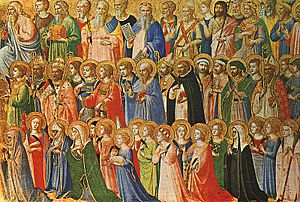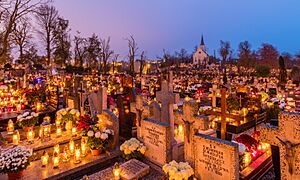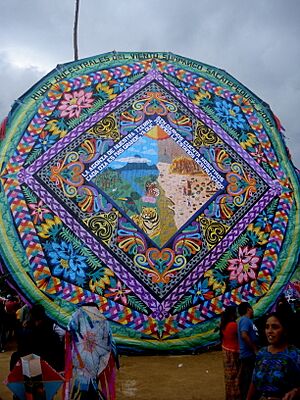All Saints' Day facts for kids
Quick facts for kids All Saints' Day |
|
|---|---|

The Forerunners of Christ with Saints and Martyrs by Fra Angelico
|
|
| Also called | All Hallows' Day Hallowmas Allhallowmas Feast of All Saints Feast of All Hallows Solemnity of All Saints |
| Observed by |
|
| Liturgical color | White (Western Christianity) Green (Eastern Christianity) |
| Type | Christian |
| Observances | Church services, praying for the dead, visiting cemeteries |
| Date | 1 November (Western Christianity) Sunday after Pentecost (Eastern Christianity) |
| Frequency | Annual |
| Related to |
|
All Saints' Day, also called All Hallows' Day, is a special Christian holiday. It celebrates all the saints in the Church, both those we know and those who are not famous. It's a day to remember and honor them.
This holiday has been celebrated for a very long time. Since the 300s, Christians have had special days to remember important people who died for their faith. Later, around the 800s, churches in places like Ireland and England started celebrating all saints on November 1st. This idea then spread to the wider Christian world.
Today, many Christians in the Western world, like Catholics and many Protestant groups (such as Lutherans and Anglicans), celebrate All Saints' Day on November 1st. Other Christian groups, like the Eastern Orthodox Church, celebrate it on a different day, usually the first Sunday after Pentecost. Some churches, like the Syro-Malabar Church, celebrate it on the first Friday after Easter.
Contents
Celebrating All Saints' Day
In Western Christian traditions, the celebrations for All Saints' Day begin on the evening of October 31st. This evening is known as All Hallows' Eve, or "Halloween." The holiday itself is on November 1st.
All Saints' Day is often part of a longer period called Allhallowtide. This period includes October 31st, November 1st (All Saints' Day), and November 2nd (All Souls' Day). All Souls' Day is when people remember all their loved ones who have passed away.
In many countries where All Saints' Day is a public holiday, families visit cemeteries. They place flowers and candles on the graves of their relatives. They might also say prayers to remember them. For example, in Austria and Germany, godparents sometimes give their godchildren a special braided pastry called Allerheiligenstriezel.
Christians celebrate All Saints' Day because they believe there's a special connection between people in heaven, people living on Earth, and those who have passed away. It's a day to thank God for the lives of all the saints, whether they are well-known figures like Paul the Apostle or Augustine of Hippo, or people who have inspired us in our own lives, like a grandparent or a friend.
Western Christian Traditions
All Saints' Day on November 1st is an important holiday for many Western Christian churches. This includes the Catholic Church, Lutheran churches, and the Anglican Church.
How All Saints' Day Began
The idea of celebrating all saints started a long time ago. In the 300s, Christians in different places had special days to honor martyrs. Martyrs are people who died because of their Christian faith.
Around the year 609, Pope Boniface IV dedicated a famous Roman temple, the Pantheon, to the Blessed Virgin Mary and all martyrs. This event helped establish a day to remember many saints.
Later, in the 700s and 800s, the celebration of all saints became more widespread. Churches in places like Ireland and England began to celebrate it on November 1st. This date eventually became the official day for All Saints' Day across the Catholic Church. In 835, Emperor Louis the Pious made November 1st a required holiday throughout his empire.
Catholic Traditions
For Catholics, All Saints' Day is a very important day. It's called a "holy day of obligation," meaning Catholics are encouraged to attend Mass. Families often visit cemeteries during this time, especially on October 31st, November 1st, and November 2nd. They go to remember and pray for their loved ones who have passed away.
Protestant Traditions
Many Protestant churches also celebrate All Saints' Day. This includes Lutherans, Anglicans, and Methodists. They use this day to remember all Christians who have passed away.
In some Lutheran churches, the special color for this day is white. During church services, they might read the names of people from their community who have died in the past year. A bell might ring, or a candle might be lit for each name. It's a time to remember those who have died in faith and to celebrate hope.
Methodist churches often celebrate All Saints' Day on the first Sunday of November. They remember not only famous saints but also members of their own church family who have passed away. Sometimes, a candle is lit for each person's name during the service.
All Hallows' Eve (Halloween)
October 31st is the evening before All Saints' Day, known as All Hallows' Eve. In many countries like Ireland, the United Kingdom, the United States, and Canada, Halloween is a popular celebration.
Christian churches, including Catholic, Lutheran, and Anglican, hold special services on All Hallows' Eve. Historically, this was a day of fasting for many Western Christians. Today, some churches host "light parties" as an alternative to traditional Halloween activities.
During the Allhallowtide season (October 31st to November 2nd), many Christians visit cemeteries. They pray and decorate the graves of their loved ones with flowers and candles. While Halloween has become largely secular, some Christian groups still connect it to its religious origins.
Songs for All Saints' Day
In English-speaking countries, churches often sing hymns like "For All the Saints" on this day. Another popular song is "I Sing a Song of the Saints of God". These songs help people remember and honor the saints.
Eastern Christian Traditions
The Eastern Orthodox Church celebrates All Saints' Day on a different date. They usually observe it on the first Sunday after Pentecost. This day is called All Saints' Sunday.
This tradition dates back to the 300s or 400s in places like Constantinople. It became more important in the 800s. On this Sunday, special readings and hymns are added to regular church services to honor all saints, both known and unknown.
Lebanese Maronite Tradition
In Lebanon, November 1st is a holiday due to Western influences. However, the traditional Maronite celebration for all saints is on one of the Sundays before Lent. This Sunday is called the Sunday of the Righteous and the Just.
East Syriac Tradition
In the East Syriac tradition, All Saints' Day is celebrated on the first Friday after Easter Sunday. This is because they believe all faithful people who have passed away are saved by Jesus and rise with Christ. Fridays are generally days to remember departed souls in their liturgy.
Customs Around the World
All Saints' Day is celebrated with many unique customs in different countries.
Europe
Austria and Bavaria
In Austria and Bavaria, godparents give their godchildren a braided sweet bread called Allerheiligenstriezel. Families also visit and decorate the graves of their loved ones.
Belgium
In Belgium, All Saints' Day is a public holiday. People visit cemeteries to place chrysanthemums on the graves of their deceased relatives.
Croatia
In Croatia, All Saints' Day (Svi sveti) is a public holiday. Families place candles and flowers on graves. Cities often provide free public transport to cemeteries.
France
In France, the day is called La Toussaint. People place flowers, especially chrysanthemums, or wreaths on tombs and graves. November 1st is a public holiday.
Germany
In Germany, Allerheiligen is a public holiday in five states. It's considered a "silent day," meaning public entertainment events are limited to keep the serious nature of the day.
Hungary
In Hungary, Mindenszentek napja (All Saints' Day) is a national holiday. Families visit cemeteries to place candles and flowers, especially chrysanthemums, on graves. Many people travel to distant cemeteries for this.
Poland

In Poland, Dzień Wszystkich Świętych is a public holiday. Families gather to tend to graves, light candles, and leave flowers. The day after, November 2nd, is All Souls' Day (Zaduszki), which is also widely observed to honor the dead.
Portugal
In Portugal, Dia de Todos os Santos is a national holiday. Families remember their dead with religious services and cemetery visits. Children celebrate Pão-por-Deus, going door-to-door (like Trick-or-treating) to receive cakes, nuts, and sweets.
Spain
In Spain, el Día de Todos los Santos is a national holiday. People bring flowers to the graves of their deceased relatives. The famous play Don Juan Tenorio is traditionally performed.
Switzerland
All Saints' Day is a public holiday in some parts of Switzerland. People bring flowers and light candles in cemeteries. They also bake special breads like Allerheiligenstriezel. These breads were originally for children and the poor who prayed for the dead.
Americas
Guatemala

In Guatemala, All Saints' Day is a national holiday. Guatemalans prepare a special cold meal called fiambre with meats and vegetables. They visit cemeteries and often leave some fiambre for their dead. Flying colorful kites is also a custom, believed to help connect the living with the dead. Festivals with giant kites are held in towns like Santiago Sacatepéquez.
Mexico
All Saints' Day in Mexico is the first day of the Day of the Dead (Día de Muertos) celebration. This first day, called Dia de los Inocentes, remembers children who have died. The second day celebrates all deceased adults.
Philippines
In the Philippines, Allhallowtide is known as Undás or Todos los Santos. Filipinos visit their families' graves to clean and repair tombs. They say prayers and leave offerings like flowers, candles, and food. Many families also have reunions at the graves, with feasting and socializing.
Pangangaluluwa and Trick-or-Treat
The Philippines has an old tradition called pangangaluluwa, similar to trick-or-treating. In the past, people dressed as spirits would go from house to house, singing. If they didn't receive rice cakes, they might play tricks, like stealing slippers. This tradition still exists in some rural areas.
Cemetery Visits and Family Gatherings
During Undas, families visit the graves of loved ones. They believe that by offering food, candles, and flowers, they remember and honor the spirits. This practice of visiting burial sites is very old in the Philippines.
Undas is also a family holiday. Family members living elsewhere often return to their hometowns to visit ancestral graves. Families are expected to stay at the grave for the entire day, strengthening their bonds. It's considered bad luck to fight during Undas.
Children's Role in Traditions
Children are sometimes allowed to play with melted candles left at tombs, shaping them into wax balls. These round balls symbolize that everything returns to its beginning, just as the living will eventually return to dust. Some families also light candles at their front door, one for each departed loved one, believing the lights guide the spirits.
Public Holidays
November 1st is a fixed public holiday in many countries around the world. These include Andorra, Austria, Belgium, Benin, Burkina Faso, Burundi, Cape Verde, Central African Republic, Chad, Chile, Colombia, Congo, Croatia, East Timor, France, French Guiana, French Polynesia, Gabon, Guadeloupe, Guatemala, Hungary, Italy, Ivory Coast, Lebanon, Liechtenstein, Lithuania, Luxembourg, Madagascar, Martinique, Mauritius, Peru, Philippines, Poland, Portugal, Saint Barthélemy, Saint Martin, Saint Pierre and Miquelon, San Marino, Senegal, Seychelles, Slovakia, Slovenia, Spain, Togo, the Vatican, and Venezuela.
In some countries, like Sweden, Finland, and Estonia, the All Saints public holiday is observed on the Saturday between October 31st and November 6th.
See also
 In Spanish: Día de Todos los Santos para niños
In Spanish: Día de Todos los Santos para niños
- 1755 Lisbon earthquake which occurred on this day and had a great effect on society and philosophy
- Dziady
- Irish calendar
- Litany of the Saints
- Veneration of the dead


